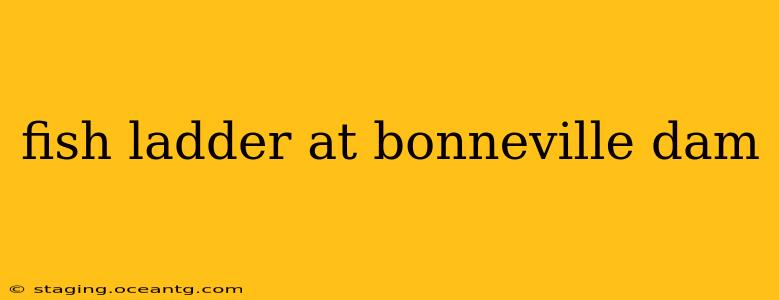The Bonneville Dam, a behemoth of engineering on the Columbia River, is more than just a hydroelectric powerhouse. It's also a critical piece of infrastructure dedicated to the survival of migrating salmon and other fish species. At its heart lies the iconic fish ladder, a marvel of design that allows these creatures to bypass the dam and continue their crucial life cycle journeys. This article explores the Bonneville Dam fish ladder in detail, answering common questions and delving into its importance for the ecosystem.
What is the purpose of the fish ladder at Bonneville Dam?
The primary purpose of the Bonneville Dam fish ladder is to mitigate the impact of the dam on migrating fish. Before the dam's construction, salmon and other anadromous fish (those that spend part of their lives in freshwater and part in saltwater) freely navigated the Columbia River. The dam, however, created a significant barrier, preventing them from reaching their spawning grounds upstream. The fish ladder provides an alternative route, allowing fish to swim around the dam and continue their migration. This is crucial for the survival of these species and the health of the entire Columbia River ecosystem.
How does the fish ladder at Bonneville Dam work?
The Bonneville Dam's fish ladder is a series of water-filled pools or "basins" connected by short, gently sloping channels. Water flows over the weirs separating each basin, creating a current that attracts fish. The fish swim upstream, using the current to propel themselves from one basin to the next. The design carefully considers the species' natural swimming abilities, ensuring a manageable climb. The system is monitored closely, and adjustments are made as needed to ensure optimal effectiveness.
What types of fish use the Bonneville Dam fish ladder?
Many species of fish utilize the Bonneville Dam fish ladder, but salmon (Chinook, Sockeye, Coho, and others) are arguably the most prominent. Other species, including steelhead trout, sturgeon, and lamprey, also use the ladder to bypass the dam. The diverse range of species highlights the importance of this structure in preserving the biodiversity of the Columbia River.
How many fish use the Bonneville Dam fish ladder each year?
The number of fish using the Bonneville Dam fish ladder fluctuates annually depending on various factors, including water conditions, the overall health of the fish populations, and the effectiveness of other conservation efforts. However, it consistently serves hundreds of thousands, even millions of fish each year. Monitoring data, collected meticulously by the U.S. Army Corps of Engineers and other agencies, provide valuable insights into the overall success of the fish ladder and the health of the fish populations.
How effective is the Bonneville Dam fish ladder?
The effectiveness of the Bonneville Dam fish ladder is a subject of ongoing research and debate. While it undeniably provides a crucial passage for migrating fish, its efficiency isn't perfect. Some fish may still be unable to navigate the ladder successfully, or they may choose alternative routes that might not be as safe or efficient. Furthermore, the dam's presence still represents a significant disruption to the natural migration patterns. Research continually evaluates improvements and potential enhancements to increase its effectiveness.
What are some challenges associated with the Bonneville Dam fish ladder?
Maintaining the Bonneville Dam fish ladder presents ongoing challenges. These include keeping the water flow and the ladder structure in optimal condition, managing potential blockages from debris or injured fish, and adapting the system to changing environmental conditions. Furthermore, scientists continuously study and improve the ladder's design to optimize its effectiveness for the various species that rely on it for their survival.
The Bonneville Dam fish ladder stands as a testament to human ingenuity and our ongoing efforts to balance energy production with environmental stewardship. Its ongoing success and continued development are crucial for the preservation of the Columbia River's iconic fish populations and the entire ecosystem.
